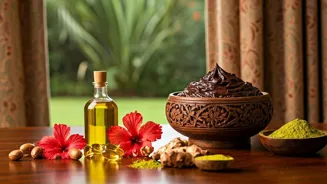From damp to dazzling – win the monsoon hair game.
The lush greenery, the smell of wet earth, chai with pakoras make Indian monsoon magical. But for your
hair? It’s a test of patience. High humidity, excess moisture, and constant dampness create the perfect environment for frizz, hair fall, dandruff, and limp locks. If you’ve ever wondered why your hair feels like it’s in rebellion mood during the rainy season, you’re not alone.
Why Your Hair Suffers in the Rains
Humidity makes the outer layer of your hair, the cuticle, swell and open, allowing moisture in – resulting in frizz. The constant dampness also leads to fungal growth on the scalp, causing dandruff and itchiness. Additionally, the rainwater in cities is often acidic and polluted, which can weaken hair roots and cause breakage.
Monsoon Hair Problems at a Glance

Frizz Frenzy: Humid air swells hair shafts, making them unmanageable.
Increased Hair Fall: Weakened roots due to moisture imbalance.
Dandruff & Itchy Scalp: Fungal infections thrive in damp conditions.
Limp & Lifeless Locks: Excess moisture weighs down hair.
Treatments & Tips for Healthy Hair in Monsoon

Switch to a Gentle, Anti-Frizz Shampoo
Opt for a sulphate-free shampoo that cleanses without stripping natural oils. Look for ingredients like keratin, argan oil, or aloe vera to tame frizz.
Pro Tip: Wash your hair at least twice a week to keep your scalp clean, but avoid overwashing as it can make hair brittle.
Condition, Condition, Condition
In monsoon, your conditioner is your best friend. It seals the cuticle, reducing frizz and locking in moisture. Apply conditioner mainly to the mid-lengths and ends – not the scalp.
DIY Fix: Mix honey with yogurt for a natural deep-conditioning mask.
Fight the Dandruff Menace
An anti-fungal shampoo containing zinc pyrithione or ketoconazole works wonders. You can also use neem water rinses once a week to keep scalp infections at bay.
Natural Remedy: Warm coconut oil infused with neem leaves can soothe an itchy scalp.

Keep It Light – Styling Products
Heavy serums and creams can weigh hair down in humid weather. Choose a lightweight leave-in conditioner or hair serum with silicone to smoothen strands without making them greasy.
Dry Your Hair the Right Way
Never tie wet hair – it traps moisture and promotes fungal growth. Pat your hair dry with a microfiber towel, avoid vigorous rubbing, and let it air-dry before styling.
Oil – But Not Too Much
A warm oil massage once a week can improve blood circulation and strengthen roots. But avoid keeping oil overnight in the monsoon – the damp weather can attract dust and microbes.

Eat for Healthy Hair
Nutrition is key. Include protein-rich foods like dal, paneer and Vitamin C-rich fruits (for example guava, oranges, amla) to strengthen hair from within.
Quick Anti-Frizz Hacks for Rainy Days
Use a silk or satin pillowcase to prevent breakage.
Keep an umbrella or scarf handy to protect hair from acidic rainwater.
Braid your hair or tie it in a bun to avoid tangles when outdoors.
Monsoon Hair Myths – Busted!
Myth: You shouldn’t wash your hair often in monsoon.
Fact: Keeping your scalp clean is more important than avoiding washes.
Myth: Rainwater is pure and good for hair.
Fact: In Indian cities, it often contains pollutants that damage hair.

The monsoon may bring frizz, dandruff, and hair fall, but with the right care, you can keep your locks looking gorgeous even in this weather. A little extra love – from a nourishing diet to protective hairstyles – can go a long way.
So, next time the skies open up, step out with confidence – because your hair is rain-ready!











